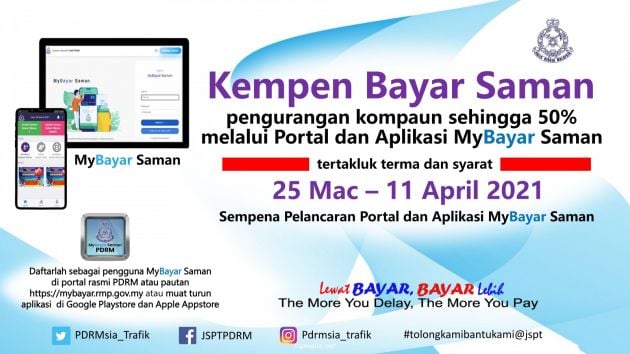The PDRM’s traffic investigation and enforcement department (JSPT) has come up with the MyBayar Saman online portal and smartphone app, which will allow for direct payment of summonses. It will be launched today by inspector-general of police Tan Sri Abdul Hamid Bador in Bukit Aman.
According to JSPT, they’ve launched this fast and easy avenue to suit today’s trend of people shifting to online and phone transactions. The department says that on average, it has issued 5.37 million summonses a year (2016-2020) and analysis shows an increasing trend of online payment of summonses – last year, 46.7% used e-payment compared to just 18.5% in 2019. The new normal that Covid-19 brought about surely influenced the trend.
To use MyBayar Saman, you will need to go to the online portal (mybayar.rmp.gov.my) or download the app to your phone. Fill in your particulars as well as the OTP that will be sent to your phone. Then, log in, semak, and choose the summonses that you want to pay off. Choose your payment mode (FPX or credit/debit card), hit the pay button and you’re done. The app has transaction history, too.
It sounds pretty straightforward, and if you want to try it out, PDRM is offering an introductory offer of sorts with a 50% discount on summonses paid via MyBayar Saman. The offer is from today till April 11, and terms and conditions apply.
Looking to sell your car? Sell it with Carro.














AI-generated Summary ✨
Comments express frustration with the new MyBayar Saman app and online portal, citing technical issues like difficulty in making payments, OTP failures, and system upgrades causing delays. Many users are unhappy with the complicated processes, lack of user support, and concerns over security. There is also criticism of the system's reliability, especially for company vehicles and those registering under old IC numbers. Several commenters appreciate the 50% discount promotion but feel the platform is inefficient or poorly functioning, leading some to prefer traditional payment methods or wait for discounts during specific events. Overall, sentiments are largely negative, focusing on technical frustrations, system unreliability, and doubts about effectiveness.